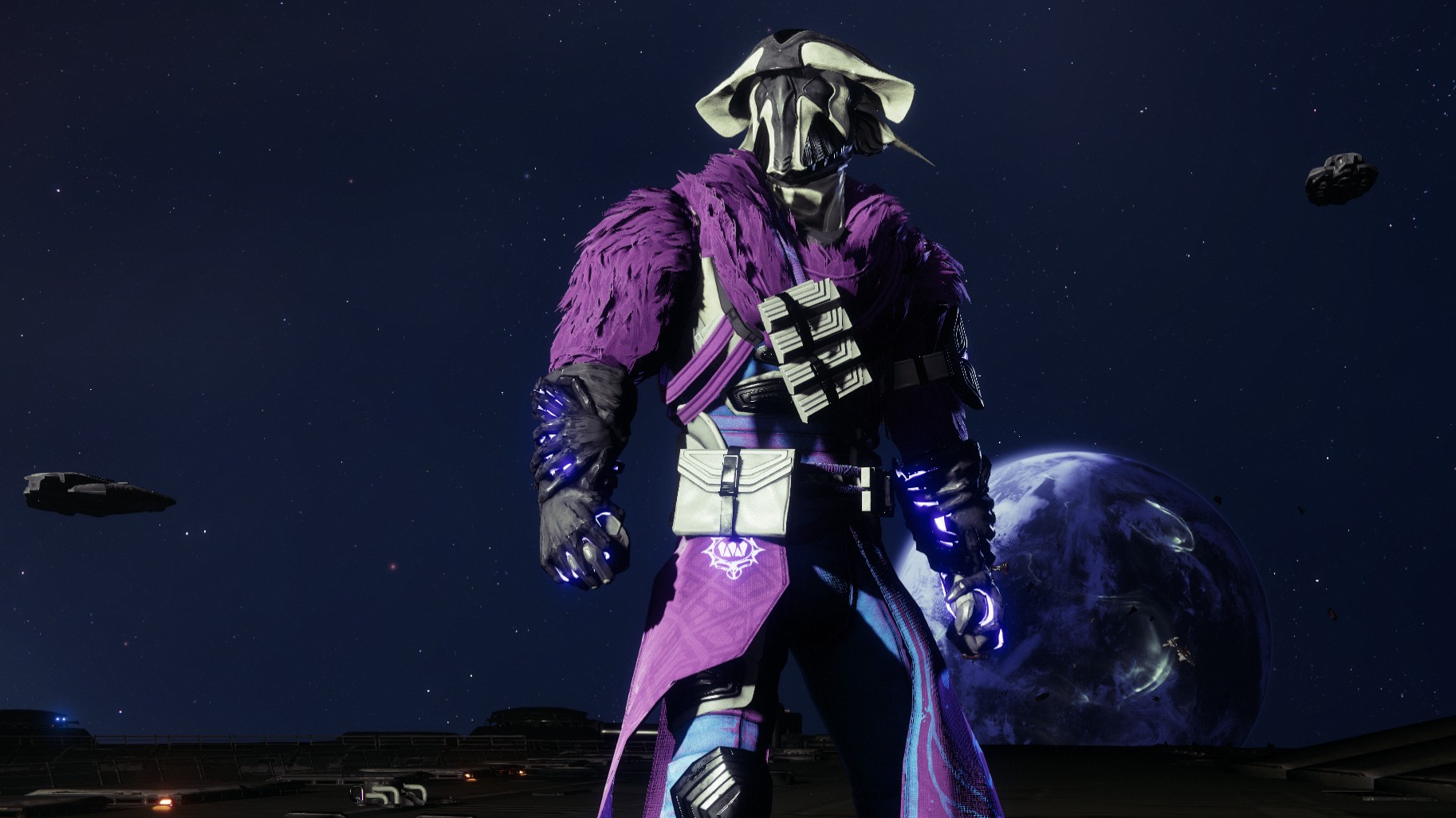Our Verdict
A disappointing campaign, and a sandbox rework that shows promise, but feels like it's still some major balance patches away from leaving the game in a good place.
PC Gamer's got your back
What is it? The fifth Destiny 2 expansion. This one is very purple.
Release date Feb 28, 2023
Expect to pay $50/£40
Developer Bungie
Publisher Bungie
Reviewed on Ryzen 7 3700X, 32GB RAM, RTX 3080Ti
Steam Deck Unsupported
Link Official site
An expansion launch is a significant moment for Destiny 2, and not just because of the new campaign, destination and raid each one brings. Expansions are also a statement of intent—making dramatic, sweeping sandbox changes that alter the very feel of the game at large. Last year, with The Witch Queen, Bungie began the process of reworking the game's original subclasses, and the results were potent to say the least. Armed with a new, more flexible suite of tools, Guardians created some of the most powerful builds in the game's history.
Lightfall, in contrast, has an unenviable task: Getting players excited for their cool new powers while also undoing the power creep.
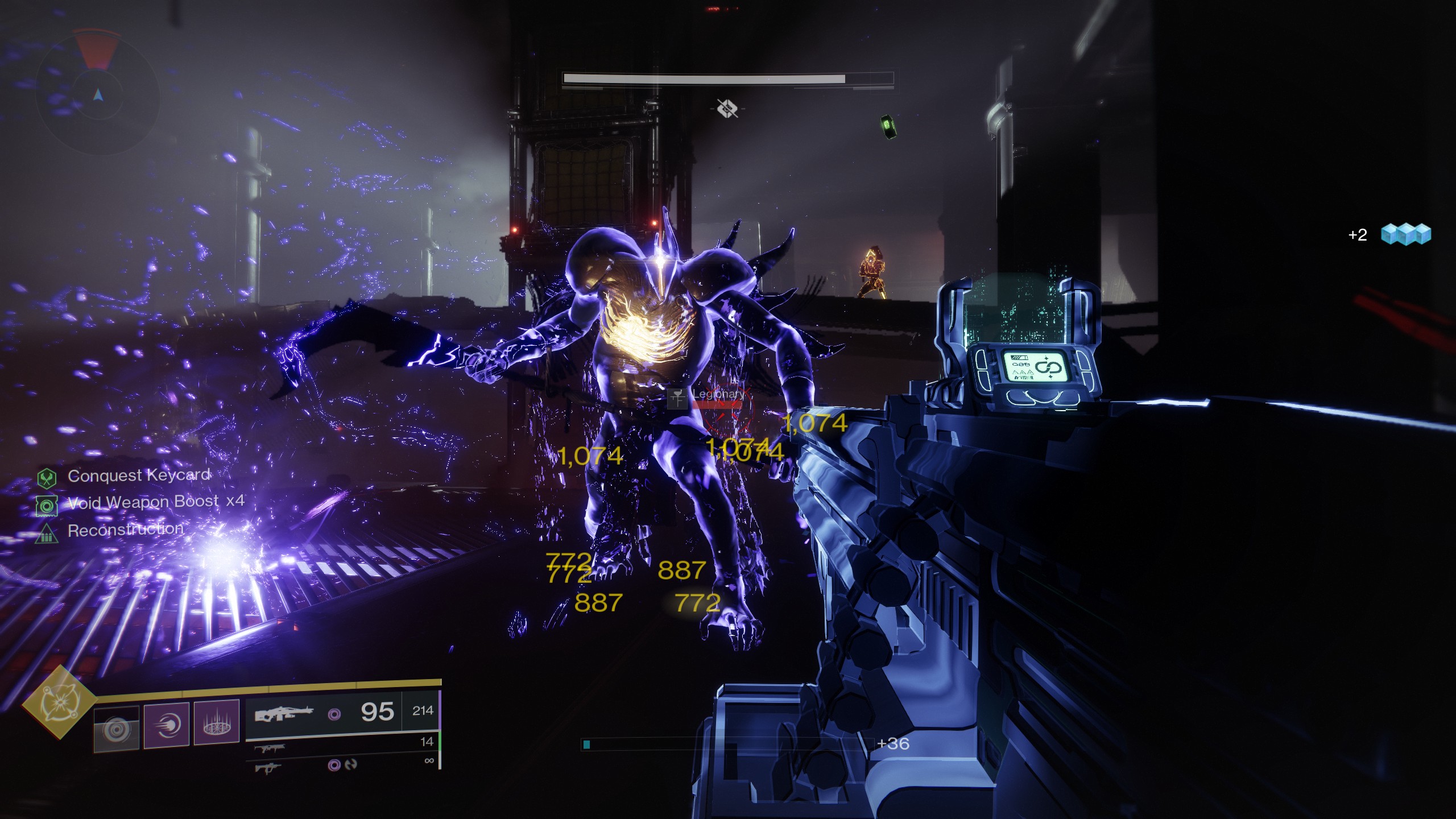
Abilities take longer to recharge, enemies hit harder and tank more damage, and it's no longer possible to outlevel certain activities. We've spent a full year gorging on ice cream, and now Lightfall is here to remind us that, no, we also have to eat our broccoli. In this analogy, the broccoli is machine guns.
This was always going to be a hard sell. I love a challenging encounter that forces me to pick the right tools for the job, but it's hard to deny the giddy thrill of clearing an entire room of enemies with absurdly overpowered space magic. Destiny 2 feels different now—less approachable and quicker to punish a mistake. While many of the changes were arguably necessary, I'm not surprised that players aren't as hyped about the game at large.
An incredible campaign would, at least, have distracted the playerbase as Bungie ushered in this new era of disempowerment fantasy. Unfortunately, as you'll know if you've caught a whiff of the community backlash that followed immediately in the wake of its launch, that's not what happened. Lightfall's campaign is a mess.
In terms of the story, Bungie has again returned to the infuriating narrative trick of having characters talk about the importance of The Noun without ever doing the work to explain why you should be invested in it. We follow Osiris to Neptune—discovering the hidden city of Neomuna and meeting Nimbus and Rohan, two cybernetically enhanced Cloudstriders, when we land. Immediately allying with them, we begin working to stop the Witness from retrieving "the Veil".
Leading the charge on behalf of the Witness is former Cabal emperor Calus and his new Shadow Legion. In the third mission, we're asked to board his ship in order to destroy "the Radial Mast" before he can connect it to "the Veil".
"Wait," says Osiris. "A source of paracausal energy? It could be the Radial Mast."
"The Shadow Legion have the corridor locked down tight," says our Ghost. "Even if we could fight through, they'd have enough time to secure the Radial Mast."
"There must be more than one path to the Radial Mast," says Rohan.
These are not quotes I've cherry picked from throughout the mission. They play one after the other. A lot has been made already about the tone of this expansion—particularly the asinine banter from Nimbus, who has never met a situation they can't quip their way through—but the problems are so much more fundamental than that. What is the Radial Mast? What will happen if Calus connects it to the Veil? What is the Veil? Throughout, Lightfall does a terrible job of setting the stakes of our missions, making them feel inconsequential. Outside of the first and last cutscene, everything here feels like a disposable sidequest.

Lightfall rushes through plot beats and character arcs, never giving one enough time to germinate into something interesting or coherent. Instead of doing the work to show Osiris reckoning with his grief over the loss of his Ghost, his character shifts wildly, bafflingly in tone from one mission to the next. Instead of fleshing out the genuinely tense and compelling cutscenes between Calus and the Witness, we're left to reverse engineer the Witness's likely plan of using the former emperor as a disposable lure for the Guardian. Instead of getting to know Neomuna as a living, functioning civilization, we discover that its citizens are hiding from the invasion inside Neptune's version of the metaverse, leaving the city feeling deserted—just another barren destination biome, this time with neon.
Long live the Queen
We've been here before. Both Shadowkeep and Beyond Light gestured at good story beats, but struggled to make them work within the confines of Destiny 2's story delivery mechanisms. But The Witch Queen felt like the studio had turned a corner—it was a satisfying story, well suited to the game it was a part of. This is a step backwards.
We've spent a full year gorging on ice cream, and now Lightfall is here to remind us that, no, we also have to eat our broccoli.
Given all that, I actually don't mind the tone of the campaign leaning into an '80s action pastiche. I like the training montage—at the very least it's a moment to actually spend time with the game's characters before they send us off to defend another macguffin. And towards the end, we get a big setpiece fight alongside Caitl and her army. It's great—a satisfying payoff to the work spent developing as allies across the last two years of seasonal storylines.
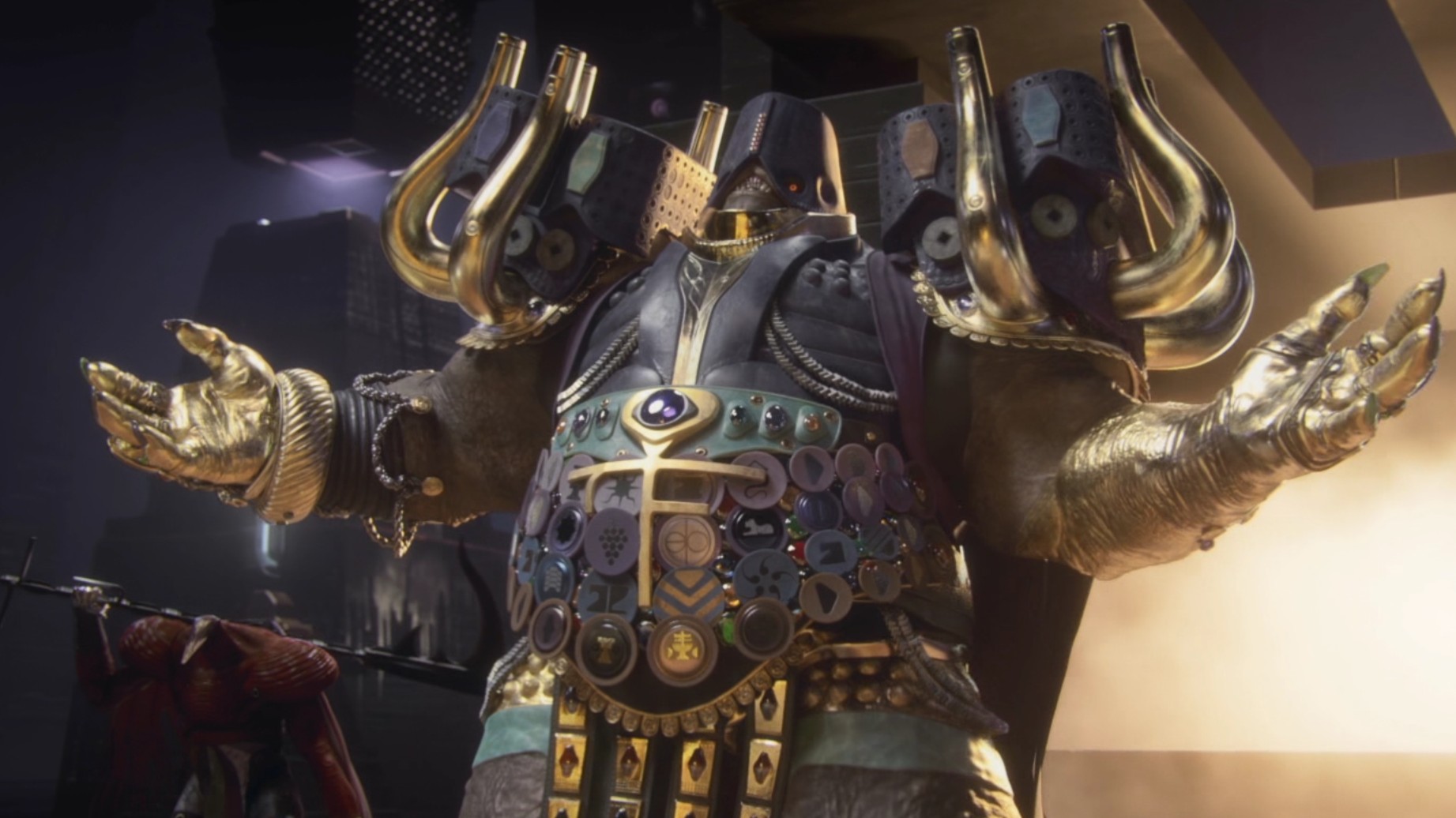
In fact, much of the encounter design throughout the campaign's missions is strong—at least in the missions that give you enough freedom to choose your own approach. That third mission to destroy the Radial Mast? Story frustrations aside, it's an engaging tour through Calus's ship—heavily based on the familiar aesthetic of the Pyramid Ships, but infused with his own gaudy flair. Throughout there's a good mix of arena size and enemy density, making missions feel varied and satisfying to overcome.
Bungie also gets some mileage out of the new Tormentors—a type of miniboss that appears in a handful of missions. The trick with them is that they're immune to damage until you take out the weak spots on their shoulders—similar to the Rhulk fight in last year's Vow of the Disciple raid. They're used effectively enough in a handful of missions, usually in smaller arenas where their habit of charging you down results in frantic, panicked kiting. Generally, though, their inclusion feels less impactful than The Witch Queen's Lucent Hive, which were more varied and interesting in the threat they posed.
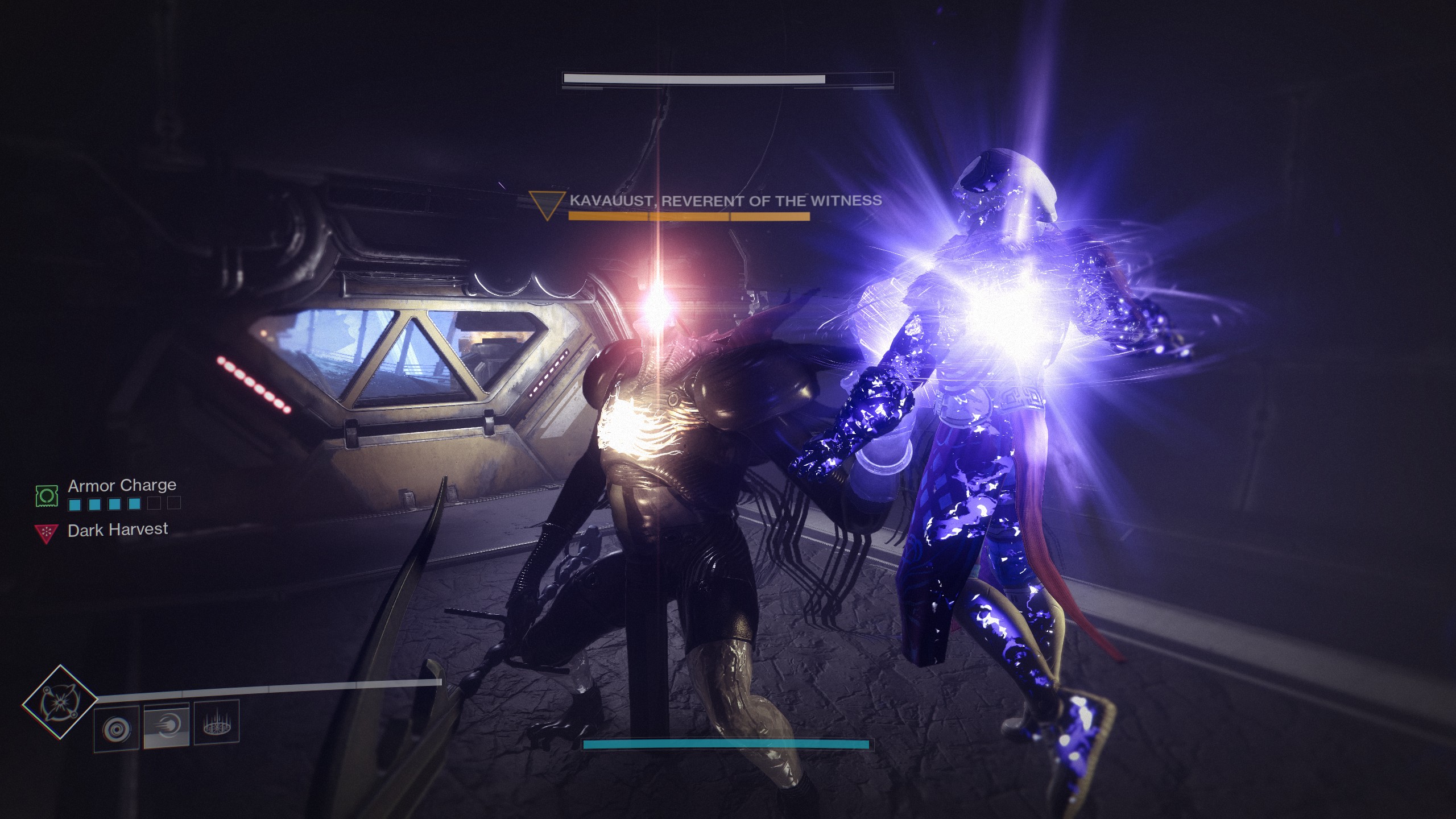
Unfortunately, a handful of campaign missions are dragged down by how Strand, Lightfall's new subclass, is incorporated into them. The entire second act of the campaign is dedicated to Strand—your mastery of it is the one story beat that feels like it's actually given time to breathe. In an eight mission campaign, having so much time dedicated to what is effectively a tutorial for your new powerset feels like a waste. I would have preferred the tutorial to remain just that—something handled separately from the campaign itself, giving the missions more space to actually tell the story.
It's made worse on legendary difficulty, which is how I played. In The Witch Queen, it felt like the harder version of the campaign was designed to reward my hours with the game up until now—the guns that I'd earned, the build knowledge that I'd accumulated. The same is mostly true of Lightfall, at least until Strand appears. In the missions that pull double duty as a tutorial, you're forced to use a pared down, skeletal version of the subclass, before finally unlocking the full thing on completion of the campaign.
Beyond Light did something similar with Stasis, but that was before Bungie used The Witch Queen to redefine what an expansion campaign could be. The new model fits awkwardly against the old—and it lessens Lightfall because of it.
Strand and deliver
Even in missions where Strand is optional, its presence is keenly felt. The final boss fight is brutal—a series of platforms over a big drop down into instant death, and packed full of enemies with knockback attacks. It's clearly built with strand in mind, and the ability to grapple your way back to safety. But taking it means losing access to more cohesive, fully customisable build options that would make the fight more survivable.
(Also, and I'm just venting here, if the purpose of an encounter is to use a grapple ability as a traversal tool to survive knockbacks, don't also include an enemy who can suppress you with their knockback, thus nullifying your grapple ability. I got very angry at this fight.)
The annoyance here is that, had we been given the fully formed subclass sooner, I would have absolutely taken it into campaign missions. Armed with the full suite of fragments and other buildcrafting options, I've been getting a lot of enjoyment out of Strand as a middle ground between the crowd control offered by Stasis and the more offensively focused Light subclasses.
On Warlock—the only character I've completed the campaign on so far—I've dropped the grapple grenade in favour of two primary builds. One uses Necrotic Grips to juice up the unravel damage effect with free poison tick damage, while the other goes all in on Threadlings—the flowing green minions that seek out and jump on enemies. They're often wildly inconsistent, but I can't help but cackle whenever I consume a grenade and cast a rift to send eight of them scurrying towards a pack of enemies.
Threadling Army"
In terms of balance, Strand is in a decent place, although some of that is likely down to the extra passive benefits provided by this season's artefact perks. If anything, it could probably use some choice buffs in the future. Grapple uptime in particular feels stingy, especially compared to the quickly recharging version you get during the campaign. Currently it gets by on the novelty alone, but once that's worn off, it feels like shackle grenades are just outright the better choice.
A lot has been made already about the tone of this expansion—particularly the asinine banter from Nimbus, who has never met a situation they can't quip their way through.
Still, with new aspects planned for future seasons, I'm mostly happy with how it's launched. Crucially, it hasn't destroyed PvP in the way Stasis did for months after Beyond Light's release. With Stasis, being frozen was a surefire death sentence. With Strand, being suspended still gives you the chance to fight back, and I've appreciated it every time I've survived being caught by a shackle grenade.
For all my criticisms of Lightfall's campaign, it's also the part of the game I will spend the least amount of time playing over the next year. After all, The Witch Queen was widely lauded, but that didn't matter months later in Season of the Plunder, when players were revolting against the drudgery of Bungie's seasonal template. As the showpiece of a new expansion, the campaign is important, sure, but it's almost tangential to the wider question of whether Destiny 2 is actually good right now.
Certainly things pick up in the post-campaign. The missions that unlock after go some way to rectifying some of the big mistakes with the campaign's story. Nimbus gets a moment to reckon with and acknowledge their loss. Characters finally bother to ask the question of what the Veil even is—not that we get an answer. And we even get to speak to some members of the virtual citizenry of the city. It's limited—characterisation in radio play form—but it's something at least.

I'm also happy with the ritual activities that populate Neomuna, particularly Terminal Override—an open world event that rotates its reward and location each day. It works a lot like last year's Nightmare Containment seasonal event, a drop-in-drop-out fight across the map, ending in a boss fight. I've jumped in a lot over the last two weeks as I search for a specific Hatchling roll on the new Strand machine gun, and it's just low-stakes and breezy enough that, unlike The Witch Queen's Wellspring, it never feels like a chore to dip into.
The seasonal side of Lightfall has been good too. Defiance instantly nails the tone of the Shadow Legion's invasion of Earth, and its main characters—particularly Amanda, Devrim and Mithrax—pair well together. It's not dour, but the threat feels serious, which gives the events a more weighty, urgent tone than that of the campaign. Defiance's Battleground playlist also feels like the most successful of Bungie's experiments with difficulty.
As in Season of the Seraph, these new Battlegrounds lock players to five points under the recommended power level, which feels like a real sweet spot for a farmable activity. It's not so easy that it's boring—you can easily die from a dumb mistake—but not so challenging that you're punished for experimenting with fun loadouts. My new favourite Battleground build revolves around the Ruinous Effigy Exotic trace rifle, which turns enemies into orbs that you can slam down for a large area-of-effect attack. It's all about charging into enemies and using its intrinsic debuffs, and the Devour healing effect given on the Void subclass, to negate any damage I'm taking. It's just a lot of fun.
Dunks"
Defiance shows that there's potential in the way Bungie is rebalancing Destiny 2's difficulty, but there are problems too. If the first few days of the expansion's launch triggered a wave of exasperated Reddit threads about the Veil, about Osiris, and about the time Nimbus tried to fistbump Caitl, the following weeks have shifted into complaints around the fact that the game is just harder now.
Rise and grind
Fundamentally, I agree with the basic problem that Bungie is trying to fix. Destiny 2 was too easy, at least for the majority of its activities. The Light 3.0 reworks completely solved add clear through their constant ability uptime in a way that hurt the sandbox—invalidating roaming supers and the very concept of machine guns. In the new sandbox, with its slower ability uptime and less powerful suite of armour mods, I'm once again back to taking Deep Stone Crypt's machine gun, Commemoration, everywhere I go. This is fine. I love a good machine gun.
But elsewhere, the sandbox hasn't shifted enough to compensate for the difficulty increases. Here's everything Bungie has done this release to make us less powerful:
- Tier 10 resilience has been nerfed, now only providing a 30% damage reduction
- Ability uptime has been reduced throughout
- Elemental Well and Charged With Light mods have been removed, in favour of a streamlined Armor Charge system that is markedly and deliberately less potent
- Enemy health has been increased, and enemies are harder to stagger
- Many activities now lock players below the recommended power level
It's those last two points that are causing the most issues, especially because, outside of some buffs to certain heavy archetypes, the weapon sandbox hasn't changed to offset the nerf to ability uptime. Primary weapons have been hit hardest—enemies have more health, and, in those activities featuring an enforced power cap, our weapons aren't doing as much damage in response. Hand cannons and pulse rifles have been underperforming for a while already, and now they feel worse than ever. The problem has now also spread to other archetypes. Unless you're equipping an SMG or bow, or using an exotic primary to benefit from the intrinsic 40% extra damage against minor enemies, you're better off not using a primary at all. That Ruinous Effigy build I'm taking into Battlegrounds? I'm pairing it with a Riptide with the Chill Clip perk, letting its slow and freeze effects take care of stunning Champions. In this current sandbox, double special loadouts just feel like the way to go.
For a developer, any new release is done within the context of a fluid roadmap—a continuous thread of what came before, and, more importantly, what's coming up next. Bungie has teased an upcoming balance pass to primary weapons—the studio didn't want to shake up the sandbox too much in a release that also added a new subclass. But for players, that context doesn't matter—it's meaningless to the experience of the live game right now.
Happy Friday! We're seeing some convo about weapon changes. We've got a balance pass coming for primary weapons in PvE in the mid-Season patch. That doesn't include nerfing SMGs, which is something we're seeing a lot of talk about. We'll have more info in the end-of-month TWAB!March 17, 2023
My other gripe is with the handling of power level this release. The idea of locking players below the recommended level of higher-difficulty activities isn't necessarily a bad one, but here Bungie has opted for the worst way to expand on the experiments they started last year. If power level was going to be locked for all legend and master difficulty activities, it should have been alongside the removal of the power grind altogether. Instead, we get the worst of both worlds: a standard expansion gear grind, with the added wrinkle of your power level not meaning much when you do finally reach the top. Previously the effect of the grind—my least favourite part of any Destiny release—was that you were able to outlevel more difficult activities, giving you the feeling of at least being more capable for the effort you put in.
Now, instead, I'm grinding in order to still be underpowered for the end game. This, at a psychological level, just feels bad. The power grind was already a chore, and now it's an entirely meaningless one too.

In terms of how much players are being underleveled, legend difficulty—confusingly a different thing to the legendary difficulty modifier used for the campaign—currently feels too harsh. Thanks to the higher baseline power requirement, and coupled with being locked to 15 power levels under that recommended level, the jump in difficulty from hero to legend Nightfalls simply feels too large. Older activities, like legend Dares of Eternity, are just more of a chore to complete than they were just a few weeks ago. And the legend version of the new exotic quest, Avalon, is practically the hardest thing in the game right now.
But by far the worst offender is the legend Lost Sectors. These actually don't lock you under the recommended power level—an inconsistency that is not explained well in-game—but because that level is now 20 points above the pinnacle cap, in practice it doesn't matter. Most players are just not going to raise their artefact level high enough for it to make a difference.
The overall reward structure needs significant work to actually match the effort that players are now putting in.
The thing is, legend Lost Sectors are not really an optional extra challenge. Completing them solo is the only way to unlock any exotic armour piece released since the launch of Beyond Light. And even aside from the fact that their droprates are abysmal, with no option for focusing the specific armour piece that you want, they are nevertheless intrinsically tied to one of the core elements of buildcrafting. I'm all for master difficulty and above being a proper challenge, but legend should be pitched as the entrypoint into endgame—something that newer players can reasonably and effectively accomplish in order to earn the tools and experience they need to tackle those harder challenges.
Bungie has said that we can expect more experiments with difficulty and power level throughout the next year, but, as with the potential primary weapon changes, that doesn't really help the experience of the live game right now. Perhaps most importantly, the overall reward structure needs significant work to actually match the effort that players are now putting in.

One of the most consistently frustrating things about being a Destiny 2 player is that Bungie rarely gets a system right on its first release. When armour transmog was released, it was an overengineered mess of currencies that unlocked different currencies. When crafting arrived, it was much the same. Naturally, then, when Bungie announced that loadouts were finally being added to the game, I was worried. And while, yes, it's weird that you have to flawless a legend Lost Sector by yourself to unlock all 10 loadout slots on offer, overall I'm happy with the implementation here.
Loadouts are easy to make, and easy to switch between. Equip your armour, weapons, mods, ornaments and shaders, and click an empty loadout slot and everything is instantly saved. Click on a previously saved loadout, and you'll instantly switch to it—even inside an activity. For the most part, it just works. I'd like more loadout icons, and it's slightly annoying that I have to pick from a small list of pre-set names rather than being able to name them myself. I'd love to have more loadout slots, or a way to group them more easily by subclass or activity. But these are more quality-of-life improvements. By and large, the system works.
Loadbearing
The biggest point on my wishlist for loadouts is the ability to apply seasonal artifact perks to them. The artifact has changed for Lightfall, and now, instead of a mod that you have to slot into your armour, is a passive bonus that's always active once unlocked. But you can only select 12 of the 25 available options at one time—a concession to balance given how powerful some of the effects are. The problem is I naturally want different perks for a Void build than I do for a Solar one. You can reset the artifact for free, but it's a clunky system.
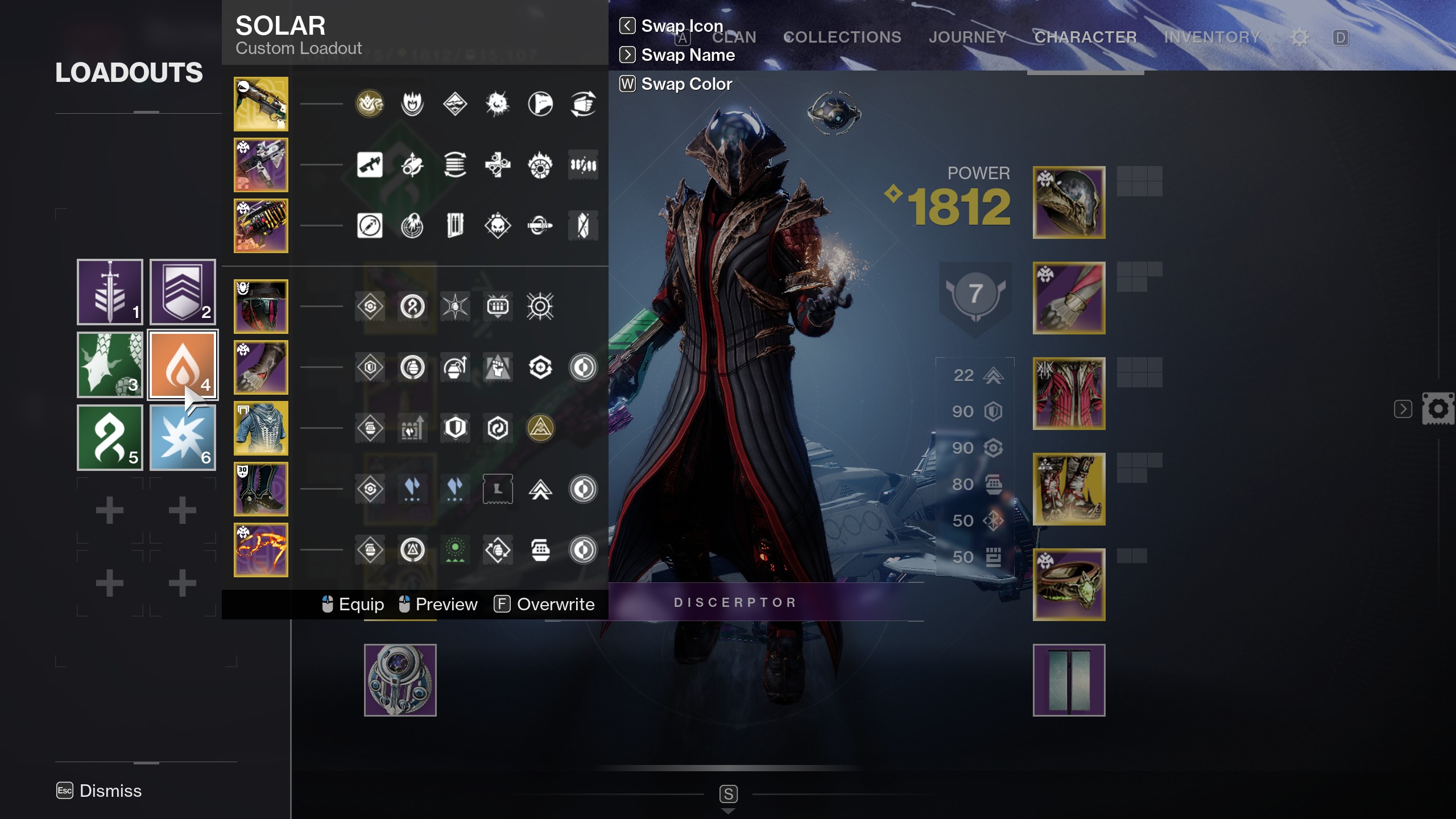
This isn't just laziness on my part, either: swapping loadout mid-activity may be fast and easy, but going into the seasonal artifact and trying to remember which pattern of perks you used for that build slows the process down significantly. Instead, I've taken to unlocking the perks that work best for both Strand and Void loadouts, and just not using the other subclasses.
Even just being able to toggle perks on and off, instead of fully resetting and reapplying them all, would make a big difference. But really, I just my artifact picks to be tied to my loadouts—becoming an intrinsic part of that instant swap.
I'm less enamoured by Lightfall's other new features: Guardian Ranks and commendations. Guardian Ranks were meant to be a way to demonstrate player experience and mastery of the game, but I'm just not sure if that's how it's working in practice. Still, two weeks on, most players I meet are at the default level of six. We'll see how that shakes out as we get deeper into the season, but at the most basic level the fact that ranks reset each season feels like a mistake. If a player is capable of completing a master raid or soloing a dungeon, those achievements aren't invalidated just because they haven't done the requisite amount of grinding of a new seasonal activity.
Commendations, too, are weird in that they tie into Guardian Ranks in a way that, of course, means players have already found a way to grind them for no effort. Fundamentally, I am just not paying enough attention to the players I matchmake with to discern which of them is "Thoughtful" and which a "Joy-Bringer". I just finish the activity, fire out some commendations at random, and go about my day. Naturally, I've also already seen the system used for BM—shout out to the one PvP lobby that piled the lowest performing player with ironic commendations. The most I can say about both of these new systems is that, as they currently exist, they are just not a significant enough part of the game to have any bearing on how I play.
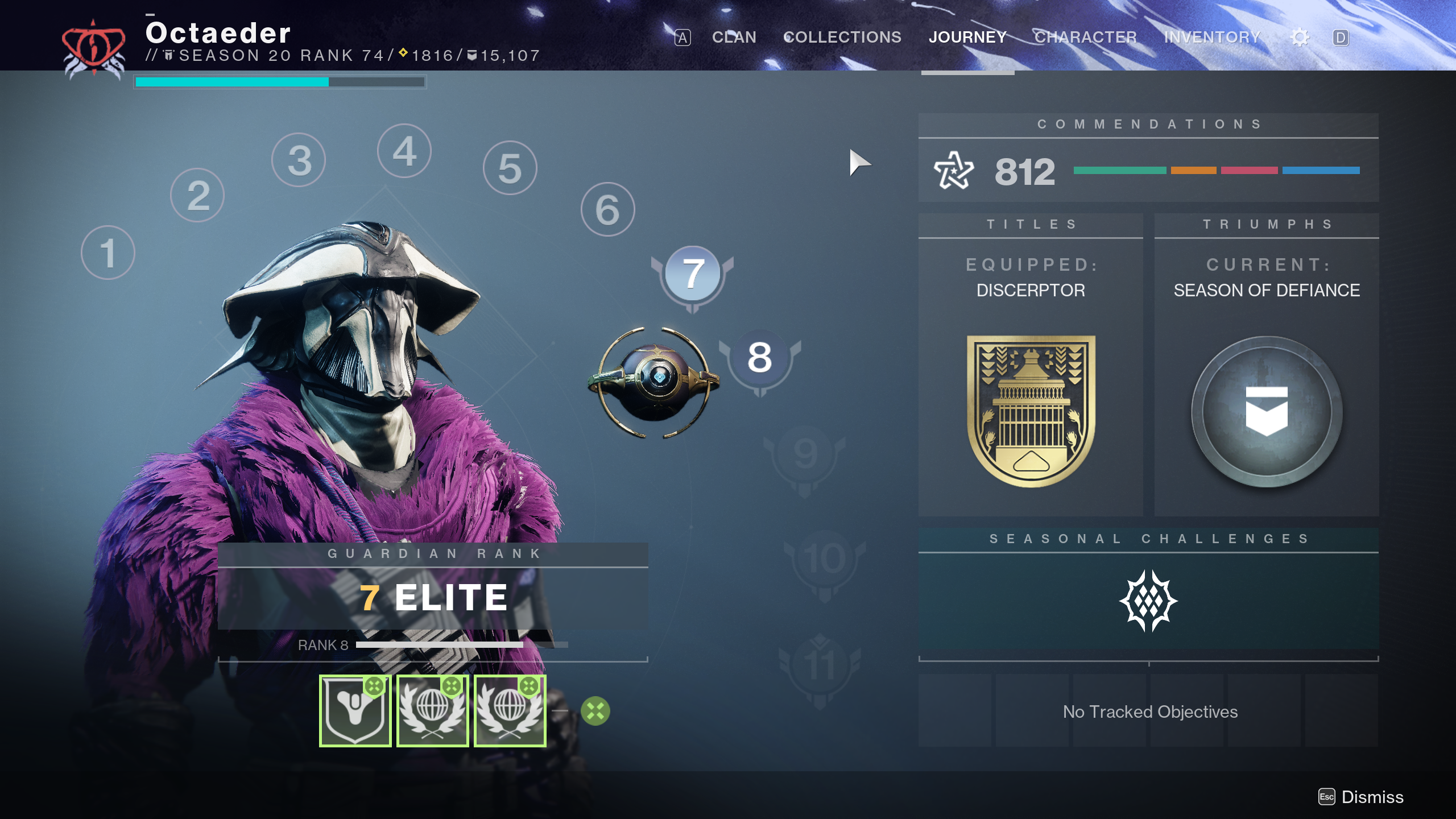
The overall feeling—the campaign, the difficulty changes and the confusing implementation of Guardian Ranks—is that Lightfall just needed more time to cook. The Witch Queen got an extra six months of development time after it was delayed, and I'm convinced that this release would have benefited from the same. This is further borne out by just how many bugs Lightfall has launched with. Some have been fixed—whatever problem with commendations was causing players to turn invisible has, just recently, been solved. But the known issues list remains lengthy, and hits on lots of small problems with weapon damage, champion counters and exotic effects. Even that list doesn't touch on a larger, longer standing issue where you can take more damage at higher framerates—a particular problem in a release that heavily features Cabal Threshers, which can easily one-shot you with a single missile.
None of the new features or sandbox changes are inherently unsalvageable, and a bunch of mishandled story beats in an uneven campaign doesn't mean Destiny 2 is suddenly bad now. The core enjoyment is still there, even around the missteps. And Lightfall isn't even Destiny 2's worst expansion—it's better than Shadowkeep by some distance. And yet, despite that, I'm scoring it lower, because Lightfall also follows on from arguably Destiny 2's best expansion in The Witch Queen.
Where that release progressed the game in some meaningful ways and delivered some crucial momentum towards the end of its narrative arc, Lightfall stumbles. It's a backwards step, both in the campaign and in the half-formed approach to implementing a new standard of difficulty. I'm hopeful that the systemic changes will, when fully fleshed out, leave the game in a better position than before. But, for now, this is the game that we have.
A disappointing campaign, and a sandbox rework that shows promise, but feels like it's still some major balance patches away from leaving the game in a good place.

Phil has been writing for PC Gamer for nearly a decade, starting out as a freelance writer covering everything from free games to MMOs. He eventually joined full-time as a news writer, before moving to the magazine to review immersive sims, RPGs and Hitman games. Now he leads PC Gamer's UK team, but still sometimes finds the time to write about his ongoing obsessions with Destiny 2, GTA Online and Apex Legends. When he's not levelling up battle passes, he's checking out the latest tactics game or dipping back into Guild Wars 2. He's largely responsible for the whole Tub Geralt thing, but still isn't sorry.
